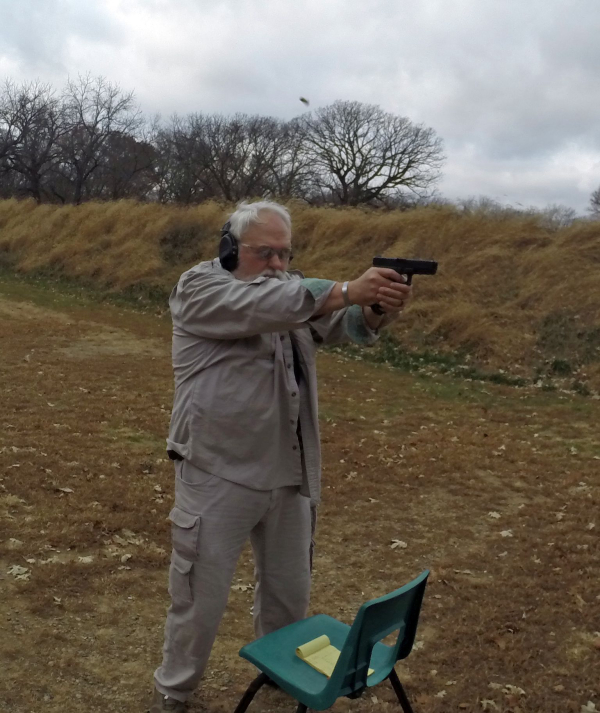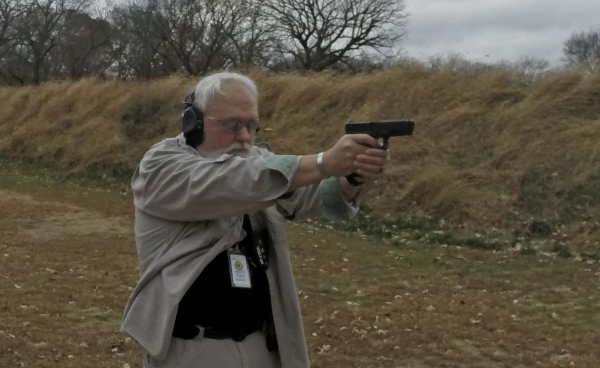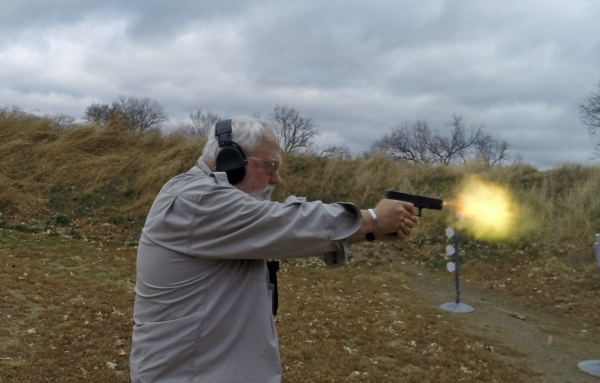
Many years ago, a police trade-in GLOCK 20 made its way here. A factory-stock scarred up duty pistol, it still wears the plastic “dovetail protector” sights. They thoughtfully provided the NY-1 trigger spring – firm, more than five pounds with the standard connector. It’s also more durable for a coastal environment than the ‘screen door’ coil spring normally used – and this gun allegedly came from an agency in Florida.
Year ago, Jim Cirillo talked me into making a multi-caliber gun out of a GLOCK 20 and recommended Bill Jarvis for the barrels. The idea was to have ‘multi-fuel’ capability, to use available ammo even if it was a different caliber from the original 10mm. I contacted Bill and he had me ship the slide to him. It returned with a barrel marked “Jarvis 355” and another marked “Jarvis 400.” The gun was now capable of feeding, chambering, extracting and ejecting 10mm, 40 S&W and 357 SIG – a true ‘multi-fuel’ pistol.
Jarvis barrels are known for their accuracy. Some ammo manufacturers have used Jarvis barrels to accuracy test their products. Gun barrel certified 4150 round bar steel is the raw material for the finished product. It’s roto-tested, x-rayed and physically tested for hardness, density, pressure resistance and chemical structure.
Aftermarket GLOCK barrels were first made by Jarvis in 1988, the first manufacturer to do so as far as I know. Barrels were available in standard and extended lengths – which can be threaded or ported. All barrels had fully supported chambers. The conventional rifling allows the use of non-jacketed projectiles, something that should be avoided in factory GLOCK barrels.
Jarvis Custom provided barrels that are drop-in, or you could send your gun or slide in to have the barrel fitted in Montana. Back then, Bill told me he sold about 25 drop-in barrels for every one sent in for fitting.
Shooting the gun back in 2004 – when I first got the rig – I found the custom barrels were quite precise. As they’re individually fitted to the gun, made in small lots, this wasn’t particularly surprising. Sadly, I see that the GLOCK 20 barrels are no longer offered, though there’s a Walther 40-to-9mm conversion system listed.

I’d wondered about shooting the big gun – this was before the Gen4 and the “SF” large GLOCK pistols – on my Comparative Standards – explained here. Then I considered shooting the standards once with the factory barrel in place, using hollow point 10mm ammo against the same gun shooting service-grade 357 SIG ammo. As I had a small supply of each, I thought this would be a good way to determine the difference (if any) between the rounds using the same pistol-holster-mag pouch.
Nontypically, I elected to start with a warm-up. I generally like to shoot the Comparative Standards cold, but I’m well aware that vast differences in a pistol’s ergonomics makes vast differences on results. While I had considerable experience with the Government service pistol going back to the late 1960s, I’d worked hard to get marginally competent with the GLOCK standard-frame size pistols (e.g., 9mm). Shooting a Commander on the Standards, for example, my times were far longer than those with a typical GLOCK 19; the difference in handling and trigger showed.
I started with Dyal’s “5-Yard Roundup.” There’s a 2.5 second par, four strings of fire: a single from the holster, four from ready (a real ready, not aimed in), three rounds from ready with dominant hand only and a pair from ready, support hand only. This is fired on the NRA B-8 repair center.
The results with the GLOCK 20 were depressing, around an 88-score using CCI 200gr TMJ Blazer ammo. Times were long enough to make it a fail. Very sad.
I changed targets to shoot the Comparative Standards. I used an out-of-print Comp-Tac Minotaur OWB and the same firm’s magazine pouch. The ammo was Hornady 10mm 180gr. XTP jacketed hollow point.


Between trying to get to where I could ‘aim by feel’ – having the sights arrive where I was looking – and managing the trigger, it was a bad performance. Not the worst I’ve ever done, but right down there with the worst. The average time to a single hit was around 3 seconds, but the quicker speeds that allowed it to be that low gave me three points down. The 10-yard pair and the 7-yard failure drill were depressingly slow. Strangely, the reload string wasn’t bad – and I didn’t miss any head shots.
While reassembling the gun with the “Jarvis 355” barrel, I applied some lube to the barrels, and where the trigger bar-connector interacts. I didn’t do a “warm up” with the 357, just set up for the standards.
I can now conclude that there can be a ‘training effect’ on the Comparative Standards – when you’re working through an unfamiliar system – the vastly larger gun (enough so that reaching the trigger makes me shoot ‘side-saddle’), the hard-to-use sights, heavier trigger. I came in nearly seven seconds quicker shooting the Jarvis-barreled gun. Using Remington 125gr JHP ammo, I came in just slightly slower than with the ‘standard frame’ GLOCK pistols in 9mm. In fact, I beat my time from the GLOCK-Lipsey’s P80 9mm pistol. That’s with a bobbled reload. I can also report no penalties – points down – with the 357 setup.
Partly lubing the gun, maybe, the custom barrel – certainly, and having consumed 70 rounds in that gun before shooting this string – they all contributed to a faster time and more precision. Before patting myself on the back, I finished with the Five-yard Roundup on a bullseye target with the Jarvis barrel installed.
It was much smoother, the times were vastly shorter – but I can still convulsively clutch the pistol while pressing through that trigger, yielding a 92/100. If I was going to use this gun – or one like it – more, I think I could make it work just fine.

It’s exhilarating to shoot 357 SIG out of a GLOCK 20; the gun handles 10mm better than any pistol I ever shot – and I was shooting a friend’s Delta Elite back in the early 1990s. The 357 SIG is loud, to be sure, and there’s more than a little blast. But there’s very little push and no snap.
What did I prove? Really nothing except that (1) dedicated practice with a particular firearm makes a difference, (2) taking care of maintenance details really helps, and (3) you can accommodate to whatever firearm is close at hand if you apply yourself to the problem.
Oh, and that Bill Jarvis makes damn fine barrels.
-- Rich Grassi